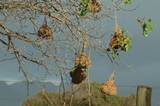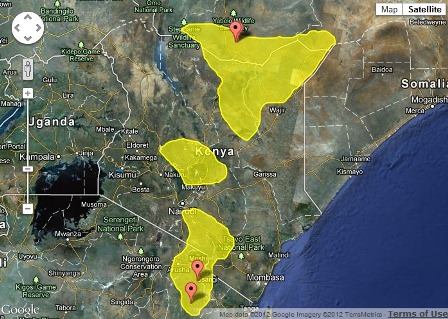Weaver news
|
The Black-capped Social Weaver Pseudonigrita cabanisi has no recognised subspecies. This species is found through southern Ethiopia, Somalia, Kenya and northern Tanzania. They forage on the ground, feeding mainly on seeds, and sometimes insects. Non-breeding flocks may be nomadic.
The Black-capped Social Weaver is colonial, with 7-61 nests in a colony. The nest is bulky, built of thin, dry grass stems and not lined. The protruding ends of the grass stems make it look untidy; sometimes several nests are so close that they merge. Roosting nests have two entrances, and one is closed for breeding nests. Both sexes add material throughout the year. One nest weighed 211 g, and contained about 9300 grass stems. Nests are often at the end of slender branches, in colonies on isolated acacia trees at about 2 m height. lt is not known if both sexes incubate (as is the case in the Grey-headed Social Weaver), but both parents and some helpers, feed the young. Photo top: adult Black-capped Social Weaver at nest, phown 714.
See a summary of PHOWN records for the Black-capped Social Weaver here. Help us to learn more about wonderful weaver colonies by submitting your photos at Virtual Museum and see the results at PHOWN (PHOtos of Weaver Nests). PHOWN records for species Previous Wedn: Red-billed Buffalo-Weaver Full species list |











 There are two species in the genus Pseudonigrita, this name meaning "false waxbill". They are small, social weavers of semi-arid parts in East Africa. The two species are distinguished by having a grey or black cap, on which the English names are based. Both species are monogamous, cooperative breeders, and build single nests of straight grass stems, which are clustered in groups in trees.
There are two species in the genus Pseudonigrita, this name meaning "false waxbill". They are small, social weavers of semi-arid parts in East Africa. The two species are distinguished by having a grey or black cap, on which the English names are based. Both species are monogamous, cooperative breeders, and build single nests of straight grass stems, which are clustered in groups in trees.
